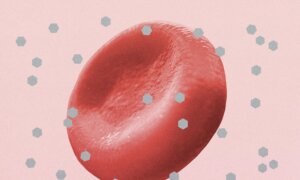Flossing may seem like a hassle for some. However, a new study adds to the evidence that flossing is worth the effort, as it may reduce the risk of stroke stemming from blood clots and irregular heartbeat. A preliminary study bolsters the research, finding that a common bacterium in the mouth is linked to an increased risk of stroke.
One should know how to avoid flossing mistakes to reap all the benefits of oral hygiene.
Flossing and Stroke Risk
The new
study, presented at the American Stroke Association’s International Stroke Conference 2025 in Los Angeles, was published in Stroke on Jan. 30. Researchers aimed to identify which dental hygiene practice—dental flossing, brushing, or regular dentist visits—is most protective against stroke.
The researchers evaluated the home use of dental floss through a structured questionnaire involving more than 6,000 people with no history of stroke and more than 6,000 with no history of atrial fibrillation. Among those who reported flossing at least once per week, 4,092 had not been diagnosed with stroke and 4,050 had not experienced a serious type of irregular heart rhythm called atrial fibrillation (AFib), which also raises the risk of blood clots resulting in stroke.
Participants also answered questions about other dental habits, including regular brushing and dental visits, and provided information regarding body mass index, smoking, cholesterol, diabetes, and blood pressure, which the researchers took into consideration when analyzing results.
The participants were followed for 25 years. During this time, 434 experienced a stroke. Of these strokes, 147 stemmed from a blood clot in a larger artery in the brain (thrombotic), 97 were caused by heart-driven blood clots (cardioembolic), and 95 were caused by hardening of the smaller arteries (lacunar). Additionally, nearly 1,300 participants experienced AFib.
Researchers linked flossing to a 22 percent lower risk of ischemic stroke (blood clot in a brain artery) and a 44 percent lower risk of stroke from blood clots traveling from the heart. Flossing was also associated with a 12 percent lower risk of AFib and reduced likelihood of cavities and gum disease. There was, however, no link between flossing frequency and reduced risk of thrombotic or lacunar strokes.
More frequent flossing was linked to more significant risk reductions, and the risk reductions were independent of regular brushing and dental visits.
“Oral health behaviors are linked to inflammation and artery hardening. Flossing may reduce stroke risk by lowering oral infections and inflammation and encouraging other healthy habits,” lead author Dr. Souvik Sen, chair of the Department of Neurology at Prisma Health Richland Hospital and the University of South Carolina School of Medicine in Columbia, South Carolina, said in a statement.
“Many people have expressed that dental care is costly,“ he said. ”Flossing is a healthy habit that is easy to adopt, affordable and accessible everywhere.”
If the results are later verified, dental health practices may be considered one of the main factors affecting general public health.
“With further research, dental health practices could possibly be incorporated into the ‘Life’s Essential 8’ risk factors, which include diet, physical activity, nicotine exposure, sleep, body mass index, blood pressure, blood glucose and blood lipids,” Daniel T. Lackland, a professor of epidemiology at the Medical University of South Carolina who has a doctorate in cardiovascular epidemiology, said in the statement.
Oral Bacteria and Stroke Risk
A preliminary study, also presented at the International Stroke Conference, further reinforces the idea that flossing may help prevent stroke.
The authors found that Streptococcus anginosus, a common bacterial strain in the mouth and gut, is present in large numbers in the guts of people who have had strokes. It is also linked to a more serious prognosis and a higher risk of death.
This discovery was built on an earlier study conducted by the same research team that found that Streptococcus mutans, a bacterium causing tooth decay, was associated with a higher risk of bleeding inside the brain.
“Our findings offer new insights into the connection between oral bacteria and the risk of stroke, as well as potential strategies for stroke prevention,” lead author Dr. Shuichi Tonomura, staff physician in the Department of Neurology at the National Cerebral and Cardiovascular Center in Osaka, Japan, said in a statement. “Both Streptococcus mutans and Streptococcus anginosus are bacteria that contribute to tooth decay by producing acids that break down tooth enamel.”
When asked how important flossing is in removing these stroke-associated bacteria from the mouth, Tonomura told The Epoch Times that flossing generally reduces bacteria-inducing dental caries and periodontitis and improves oral hygiene.
At least part of the connection between oral health and stroke involves the gut.
“We assume that reducing these bacteria from the oral cavity will be a reasonable strategy to help prevent their migration to the gut and help prevent stroke,” he said.
Mechanisms Explained
A
review published in the American Heart Journal Plus: Cardiology Research and Practice noted that epidemiological evidence suggests a potential association between gum disease and cardiovascular disease (CVD). CVD includes heart attack, stroke, coronary heart disease, and peripheral artery disease.
Researchers have hypothesized about what may underlie the association between cardiovascular disease and stroke. Bacteria from gum disease plaque enters the bloodstream and activates platelets. When activated, platelets coalesce and form a clot, which can cause a cardiovascular event.
Platelet activation can also result in the secretion of inflammatory substances that contribute to the development of fatty plaques in the arteries (atherosclerosis) and the formation of blood clots (thrombus). These inflammatory substances can result in systemic inflammation, which is also thought to play a role.
Dr. Leonard Pianko, founder and medical director of Aventura Cardiovascular Center, told The Epoch Times in an email that flossing is an essential part of gum disease prevention, along with brushing your teeth and regularly visiting your dentist. Flossing removes plaque and bacteria from your teeth and prevents gum disease, which reduces your risk of heart disease and stroke.
“Not everyone with gum disease develops cardiovascular problems, and not everyone with heart disease has gum disease,“ Pianko said. ”However, the research indicates there is a strong link, which is why it is essential to maintain good oral hygiene.”
Flossing Tips
Some people find flossing challenging, but the National Institute of Dental and Craniofacial Research offers the following
helpful tips:
- Floss By Feel Rather Than Sight: Instead of looking in the mirror when flossing, it may help to do the task just by feel. A mirror reverses the image, making coordinating the eyes and hands challenging.
- Use a Long Piece of Floss: Use at least 18 inches of floss, with the used portion wrapped around the ring and middle fingers. Shorter pieces of floss are harder to control.
- Saw Instead of Snap: Use a sawing motion instead of a snapping motion to slide the floss between the teeth. Snapping can harm the delicate tissues between the teeth.
- Try Alternatives: Water flossers, interdental brushes, and floss holders can also remove plaque from between the teeth.
Research shows that some dental floss contains potentially harmful chemicals. A study in Environmental Pollution found microplastics in floss, and Environmental Science: Processes and Impacts identified per- and polyfluoroalkyl substances (PFAS).
To minimize risk, choose floss labeled PFAS-free or opt for natural fibers such as silk instead of plastic and natural coatings such as beeswax instead of petroleum-based wax. If a floss package doesn’t list ingredients, assume it may contain harmful chemicals.
Dr. David Rizik, an interventional cardiologist at HonorHealth, shared his thoughts on flossing with The Epoch Times in an email.
“In every person’s bathroom, there is a powerful tool: dental floss. You might think it’s just about fresh breath and preventing cavities, but there’s more to the story,” he said.
“It is important that you see your dentist to discuss issues related to gum disease and bacteria formation which can cause heart and vascular disorders. That small string we call dental floss is more than a teeth cleaner—it protects your brain as well. For just $1.29 at your local drugstore, it is an easy investment in your overall health.”








